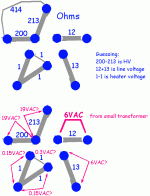You can figure it out.
Data suggests this has a 370V-0-370V and a 6.3VCT with a 117V primary.
Draw the pinout. Put an ohm meter lead on one pin. Put the other lead on every other pin. When you find a non-infinite reading, draw a line and write the Ohms. You wind up with the top illustration.
The higher voltage windings will be more turns of thinner wire so will be higher resistance. If there is a very low-power winding (such as bias), it may have high Ohms per Volt, but this example is just HV and 6V at fairly similar power (26VA and 18VA).
This lump, we expect some real low Ohms, some medium Ohms, and some high Ohms.
Make your guesses.
The fact that 414 is 200+213 tells us this is probably a HV CT winding. There's a triplet which reads "1 Ohm" all three ways, because DMMs don't read real low Ohms well, so we suspect a tapped winding but we can't tell which pin is the tap.
We suspect the 12 Ohm winding may be a 117VAC winding. Get a much lower AC Voltage. Such as a 6.3V winding from another transformer. Apply it to the presumed 117VAC winding. We expect the other windings to show 6V/117V or 0.05 of the rated voltages with full line voltage. Figure these and note on a second drawing. *Carefully* go around and measure the actual ACV on the several windings. If we guessed well, the measured ACV are in-sight of the predicted ACVs. And with the more-signal we can now tell where the CT is on the low-Ohms winding.
You may also find a pin which connects to nothing, or to the shell. This is internal shielding and for most cases you connect this to chassis; you can ignore it until the build is 99% finished and then jumper it for least stray buzz.
Data suggests this has a 370V-0-370V and a 6.3VCT with a 117V primary.
Draw the pinout. Put an ohm meter lead on one pin. Put the other lead on every other pin. When you find a non-infinite reading, draw a line and write the Ohms. You wind up with the top illustration.
The higher voltage windings will be more turns of thinner wire so will be higher resistance. If there is a very low-power winding (such as bias), it may have high Ohms per Volt, but this example is just HV and 6V at fairly similar power (26VA and 18VA).
This lump, we expect some real low Ohms, some medium Ohms, and some high Ohms.
Make your guesses.
The fact that 414 is 200+213 tells us this is probably a HV CT winding. There's a triplet which reads "1 Ohm" all three ways, because DMMs don't read real low Ohms well, so we suspect a tapped winding but we can't tell which pin is the tap.
We suspect the 12 Ohm winding may be a 117VAC winding. Get a much lower AC Voltage. Such as a 6.3V winding from another transformer. Apply it to the presumed 117VAC winding. We expect the other windings to show 6V/117V or 0.05 of the rated voltages with full line voltage. Figure these and note on a second drawing. *Carefully* go around and measure the actual ACV on the several windings. If we guessed well, the measured ACV are in-sight of the predicted ACVs. And with the more-signal we can now tell where the CT is on the low-Ohms winding.
You may also find a pin which connects to nothing, or to the shell. This is internal shielding and for most cases you connect this to chassis; you can ignore it until the build is 99% finished and then jumper it for least stray buzz.
Attachments
- Status
- This old topic is closed. If you want to reopen this topic, contact a moderator using the "Report Post" button.
